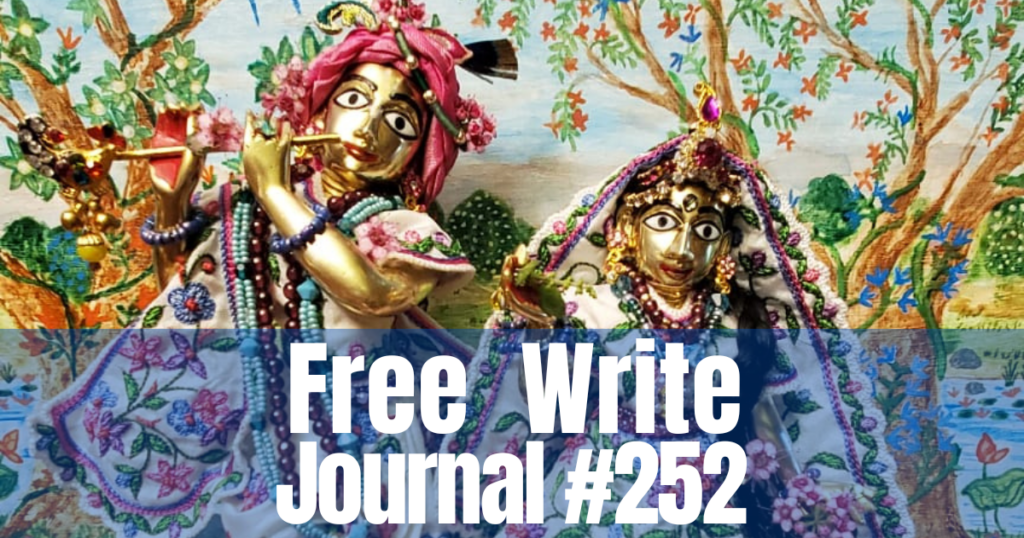
The little post office in our town of Stuyvesant Falls is being completely renovated by the new owner. But no one knows who the new owner is or what his plans are for the rest of the building. The post office will stay, but no one knows whether it’s a new apartment building or what. Is it going to remain a post office? No one knows for sure.
The post office has been a center of gossip, speculation and weather reports. The local people gather there every day and talk over these subjects, which are very important to them. How could they go without this gathering place? We (Hare Krsna devotees) try to add the mode of goodness by engaging the people in a little bit of God consciousness. But because of the heavy modes of passion and ignorance, our attempt at introducing the mode of goodness simply becomes part of the gossip. Yet they regard us as “the local priests.”
The newly published book by GN Press, The Best of a Bad Bargain, arrived today, fifty copies. They will be distributed starting on July 1st at the meeting of disciples. It tells about how to cope with chronic illness, old age, and other maladies, and keep your Krsna consciousness. Most of the book, in the first part, tells about my stay, along with Madhumangala, my assistant, at a naturopathic clinic in Madras, where we stayed for a month. The book is not one of my favorites. It’s gathered from material written long ago, but when I spoke to Krsna-bhajana and his wife, Satyasara, they told me they liked the book very much. In fact, Satyasara almost swooned and said, “I love it!” Her enthusiasm for the book changed my mind, and I decided to print it. I hope it will get some readers who will be helped by learning how to cope with illness in a Krsna conscious way.
We have set up a mechanical system that sends messages back to the people who write me letters. The message reads: “SDG won’t be answering mail until after the Fourth of July due to his laryngitis.” This will allow me to follow Ekendra’s practice when he caught laryngitis from overusing his throat muscles in narrating the SPL audiobook. He tried many treatments to cure his disease, and he wrote to me about his practice: “Resting my voice seems to be the best medicine.” The automatic message will assure my correspondents that I will write to them again as soon as my throat clears up.
Krsna dasi is working hard to prepare for the July 1 festival. She arranged for renting the VFW pavilion. She also arranged for “party insurance” for the day, as required by the VFW. She is getting new outfits for the big Gaura-Nitai, who will be the main festival Deities. She arranged with the VFW coordinator that he would allow the devotees to enter their quarters a day early so that they can clean up before the program begins. He is providing a power washer. It’s also not sure if devotees will come early to assist Krsna dasi, but she does have a crew of volunteers lined up.
It has been raining all night and all morning, with a prediction it will continue raining all day. Nevertheless, Krsna dasi here at Stuyvesant Falls was determined to get devotees and drive up and attend the Boston Ratha-yatra. The designated driver, Amith, didn’t want to go because it was raining. But Krsna dasi strongly preached to him about the importance of pulling the ropes of Jagannatha’s cart and chanting in His kirtana. She said Lord Caitanya would be very pleased, and the Boston devotees would be very pleased to see others coming to attend the festival. It would boost up their enthusiasm, even if there was rain. Amith was slow to surrender, but Krsna dasi continued her preaching until it was almost too late for them to leave. Amith finally surrendered and they left in the car. En route they picked up Atindra and Lalita-kisori. We phoned them at 12:30 P.M. to see what had come about. Krsna dasi said that the rains on the way were at first very strong, but now they had dwindled to a drizzle. So, they are hopeful.
Devotees have been giving me different kinds of potions to relieve my laryngitis. Baladeva was the first; he gave me a Chinese/Ayurvedic mix in a throat spray form, as well as lozenges. Hearing about the lozenges, Kirtan Rasa brought his three favorite kinds of lozenges, but only one of them seems to work without giving me a stomachache. Jayadvaita Swami gave me some kanthika “yogi” Ayurvedic pills that you put under your tongue. He also gave me a spray named “Singer’s,” which professional singers use. Vicaru gave me a medicated oil from Taiwan and said many “big” devotees who give many lectures use this substance. But I think Ekendra’s motto when he had laryngitis was, “Resting my voice seems to be the best medicine.”
The company has assured us that Volume One of the Journal, Worshiping with the Pen, will arrive tomorrow, June 26. They will bring it in a truck and dump probably two cases of the book on our front porch. It’s up to us to gather the cases and bring them in the house. I’m very eager to read it myself because I want to see how good it came out and whether indeed it is good and not mediocre. But tomorrow I’m not going to give out any of the books that arrive to any devotees in the ashram. I want to first offer them to Srila Prabhupada murti. The other devotees here will have to wait until July 1st when we put them at the book table for distribution.
Baladeva showed me a cardboard art piece I made many years ago. It’s created out of a Kleenex box, with a place slit for his nose and then a paper towel tube sticking out the slit and looking like a nose. I had painted them, and people were attracted to them (including myself). It reminded Baladeva and me of the whole era of my art production. It went on for ten years or more. I did most of it in Ireland. I was working so furiously, I did sometimes five big paintings a day, and many sculptures, mostly made out of wood. And they were placed in our “Visionary Garden” and dressed with raincoats for the Irish weather, and some were mounted on trees like totems. It was quite an artistic backyard. Now that era, and most of the art with it, is “gone with the wind.” I have become indifferent to it. And even if I wanted to return to it, I couldn’t get to my studio (down two flights of stairs to the basement). My original studio was dismantled and taken away when they put in a new furnace. It was like a window from Krsna that gave me the opportunity and ability to do so much artwork. It’s just like when I was working on my two volumes of My Dear Lord Krsna. At that time, I had a window in which I was able to personally talk to Krsna, enough to fill up two volumes. Now I am at the fag end of my life, and Krsna is giving me another window. This one is in writing. I am able to produce a series of Journals. I’m doing them very quickly and intensely, and it gives me a lot of joy.
It was fun to talk about Srila Prabhupada to the Polish devotees. My secretary, Madhumangala dasa, was listening, and he appreciated a few things that I said a bit differently than in the Prabhupada-lilamrta. For example, I told how the Agarwal family in Butler first received a photo of Prabhupada and knew that he was coming to stay with them. I said, “They saw the picture of him and they were frightened.” Madhu said that in the book, I emphasize that the Agarwals were uneasy, thinking that their middle-class values and their place in America might be compromised by the Swami’s coming. But I hadn’t used the word frightened. By slight changes and additions you can tell the story differently.
I said that even in his later years Prabhupada would remember those happy days at 26 Second Avenue. He invited us to take lunch with him. He watched our plates like a father and encouraged us to keep eating, “Take more! Take more!” We who had been smoking cigarettes and eating junk food found the nourishment, taste, and quantity of the food to all be wonderful. To be with Prabhupada was wonderful.
I told the Polish devotees about a young man named Stryadhisa who ate a lot. Stryadhisa was a strange young man. Before his mother allowed him to come and live with Prabhupada, she went to see Prabhupada and said that he would have to take personal supervision of Stryadhisa. Prabhupada agreed. That’s why Prabhupada paid special attention to Stryadhisa’s eating.
“Stryadhisa, more capatis?”
Stryadhisa replied, “Yes.” Prabhupada gave him four more capatis. He would eat those, and Prabhupada would ask again, “Stryadhisa, more capatis?” And again, four. Prabhupada recalled this incident many years later—how he continually gave Stryadhisa another four capatis and then another four. “But I stopped giving him at 20.”
The devotees loved to hear that, I loved to tell it, and Prabhupada seemed pleased to hear it again.
I am trying to become more conscientious to write down a thought of Prabhupada whenever it comes. The other day I suddenly remembered incidents when I was present on a walk with Prabhupada in Los Angeles.
This was very soon after Prabhupada had moved into the Los Angeles, Watseka Avenue temple. At that time, he took his morning walks by starting right at the temple door and walking around the neighborhood. Years later, Prabhupada would drive in a car to either Venice Beach or Cheviot Hills Park. This was before that started, in the early 1970s.
It proved to be a rather unpleasant walk, with a few tense moments because of the neighborhood.
I can remember myself and Karandhara present, and there were maybe two others. We started out from the temple, turned right, and walked along the sidewalk. About a block away, we saw some guys working on a motorcycle on their lawn. When we reached them, Prabhupada stopped for a moment and looked. Prabhupada was friendly and they were unfriendly. They said something. At first Prabhupada did not understand exactly what they said. We continued to walk. Prabhupada asked Karandhara what they had said, and Karandhara described it in a general way, saying that they were not very nice. Karandhara said that in general, the neighborhood was not very friendly.
Walks with Prabhupada were usually in more open settings, on the broad beach or in walkways within a park. This walk was more confined, up and down the sidewalks in the tight suburban setting. Near the end of the walk, we were down on a busy boulevard, near the location of what later became Govinda’s Restaurant. Prabhupada stopped to look in the window of a store that advertised protection against termites. There was a picture of a house that had been completely destroyed by termites. Prabhupada asked Karandhara how much it cost to get termite protection. Karandhara said it could cost as much as $10,000 dollars. Prabhupada expressed surprise in a childlike way. He said, “Oh, then let my house collapse!”
Soon after, as we were walking forward, a man approached us and handed Prabhupada a card. The man looked like a derelict, and when he spoke it was incoherent. So Prabhupada accepted the card and we kept walking, leaving the man behind.
Prabhupada said, “He is a drunkard.” The devotees affirmed that this was true. Then Prabhupada said, “In Germany it is called drinkin or drunken.”
Perhaps on this walk there was more serious philosophy discussed or serious management. But over the years that has disappeared from my mind; yet I remember these incidents. I remember feeling tense because of them. And I retain an overall impression of the devotees’ reverence and love for Srila Prabhupada.
Prabhupada can mediate between Krsna and the individual soul. For example, he explains how we can offer Krsna whatever we eat, and how the main ingredient in our offering is our devotion. Prabhupada comments, “If you offer something to Krsna, Krsna I’ve brought a very palatable dish for You to eat—no, Krsna will not take it. Naham prakasasarvasya yoga–maya–samavrta. He is not exposed to everyone.”
There are different levels of understanding Prabhupada’s teachings. A newcomer will be amazed that Krsna will accept offerings of food. Someone who has been hearing and serving Prabhupada for more years will hear with added depth and richness. Such a person is trained to hear and consider more the subtleties of the philosophy. For example, Prabhupada quoted the verse naham prakasa in the context of offering food to Krsna. The naham prakasa verse tells us that Krsna places a curtain of maya between Himself and foolish persons. To quote that verse immediately after saying that Krsna accepts offerings made in devotion produces an interesting contrast. Prabhupada’s point is that if we try to give Krsna something materially opulent to impress Him, He will not accept it, because naham prakasasarvasya—Krsna puts a barrier between Himself and such fools.
Often when Prabhupada quotes the Bhagavad-Gita, he spontaneously gives a translation which is not at all literal but interpretive. It is a kind of combined purport and translation. These little purport-translations vary from one lecture to the next and we can appreciate them as added nectar. Problems and anarthas in our devotional service can become easily solved when we carefully hear how Prabhupada attacks those problems.
Prabhupada’s disciples and followers should all be grateful to Prabhupada for his having the foresight to have his lectures recorded even as early 1966 when practically no one was attending. All he asks in return is our undivided attention.
Srila Prabhupada exposed material life as a defeat. People think they will attain happiness by sense gratification, but in the end they are only frustrated. Prabhupada taught this repeatedly because this struggle for happiness is so pervasive among the people of the world. Although most people concentrate on money-making as their goal, Prabhupada instructs them, “No, that cannot make you happy.” He also tells us not to seek liberation from material life. One may ask, “Neither sense gratification nor renunciation—what’s left?” Srila Prabhupada teaches that the goal of life is service to Krsna, bhakti-yoga. This is the message of the Six Gosvamis, Lord Caitanya, and Lord Krsna in the Bhagavad-Gita.
Often our appreciation of Prabhupada is based on appreciation of the Vedic truths. One may say that Prabhupada’s teachings are just those of a typical Vaisnava sannyasi. By glorifying Prabhupada, all we are doing is appreciating Lord Krsna in the Bhagavad-Gita. Srila Prabhupada would approve of that estimation of himself. In fact, that’s how he wanted us to appreciate him—as one who delivered Krsna’s message unchanged.
I wanted to set down here some things that happened on the plane trip. Whenever I can catch communion with Krsna, I want to remember it because the tendency is that one can have some good experience and then forget it. These experiences are the whole direction I want my life to go in; I want to shape my life accordingly.
So, on the airplane, Madhu and I had a conversation which was not ordinary talking about praying. Usually these things are better kept private, so I was hesitant to talk, but I confided in him some things such as my occasional confusion between praying to Krsna and praying to Prabhupada. He told me his own experience and it was helpful to hear. Sometimes we just want to pray to Krsna, but even at that time we don’t leave our spiritual masters. I also gave the evidence that Prabhupada taught us to chant the Hare Krsna mantra and that at the same time, he said we have to pray through the spiritual master. We don’t chant “Prabhupada, Prabhupada,” as much as “Hare Krsna, Hare Krsna.” We have to remember them simultaneously.
yadā nopalabhetāṅghrāv
ūṣmāṇaṁ patyur arcatī
āsīt saṁvigna-hṛdayā
yūtha-bhraṣṭā mṛgī yathāWhile she was serving her husband by massaging his legs, she could feel that his feet were no longer warm and could thus understand that he had already passed from the body. She felt great anxiety upon being left alone. Bereft of her husband’s company, she felt exactly as the she-deer feels upon being separated from its mate.
—Śrīmad-Bhāgavatam 4.28.46
We’ve been discussing in the evening class how Prabhupāda was responding to the false hopes the disciples were offering. They encouraged him by saying that if he took his medicine and if he got a little strength, then he would get better. Yet actually he was not getting better. But the mood was that, as disciples, they should serve the spiritual master to the end. And Prabhupāda wanted this. And that attitude of the disciple is described here: “The daughter of Vidarbha continued as usual to serve her husband, who was seated in a steady posture, until she could ascertain that he had passed away from the body.” In a sense, Śrīla Prabhupāda made his body like a laboratory of devotional service, so that the devotees could be tested—whether they would serve him to the end.
Sometimes, if a neophyte devotee sees his spiritual master ill, he may become bewildered: “If he’s a pure devotee, how is it that my guru has become ill?” Or he may become fearful: “What’s going to happen? My spiritual master is very ill. Is he feeling pain? What if he leaves? What’s going on?” So the neophyte disciple becomes fearful and bewildered, and he becomes doubtful. He may have various impure thoughts, even to the point of great offenses. He may even think that he does not want the spiritual master to stay. It seemed again and again that Śrīla Prabhupāda could not live, yet he was being encouraged by his disciples. He would drop lower, then seem to come back. The devotees became more and more absorbed in pleading with Prabhupāda to please live, and in that way they were increasing their affection for him.
This is a good instruction for all of us. The wife kept serving her husband until the symptoms of life had left his body. She didn’t put him in a nursing home or feel resigned—“Well, there’s nothing I can do for him anymore. Maybe he’ll just pass away.” She continued to hope. And this should be our attitude in Kṛṣṇa consciousness. Even if it gets difficult or we don’t like something, still we have to stick to our service at the lotus feet of the spiritual master. It’s do or die. And once you agree to do that, then there’s no bewilderment: “Well, I don’t know what’s going on, actually. Maybe I’m fearful. Philosophically, maybe I don’t understand. But all I know is that I am surrendered to my spiritual master. I’ll just do whatever he says. And I will never give up serving him until there’s absolutely no life left in my body. I’m not going to give up because of this or that. I am going to continue serving him. Even if my service is not very important by some calculation, I will do my tiny service, and this will keep me steady in devotional service.”
Tomorrow, His Divine Grace is due to arrive in Detroit. In this notebook, instead of describing my vacillating self, I shall write down the transcendental words and activities of His Divine Grace. My position is to surrender to his will without any attachment, except to do what pleases him most. At present, he seems to like my management of the library party. I can report that they are steadily going on and getting standing orders, and I have built up our party to be a self-sufficient unit, spiritually and financially. There are different departments, all directed toward the selling of books to the libraries and colleges and the collecting of laksmi to support it, as well as a program of giving college classes.
Perhaps I could simply ask his blessings and permission to continue the library party at present without change. It would be nice if the library party could have darsana with His Divine Grace. Assure him how the program is developing and ask any other questions.
He may send me wherever he desires, but for myself, I will be glad to stay on with this traveling and preaching in the U.S. I think it will develop more and more. There seems to be no need to do something different since the present work repeat visits to the universities is resulting in more and more acceptance of his books. As for my restlessness and dissatisfaction, that is definitely chronic and has to do with a lack of Krsna conscious realization, a lack of being situated in Krsna consciousness. If my program is to study, I will be discontent at not producing more by preaching; if my program is active preaching, I will be discontent not to study; if I am managing, I will complain, and if I am not managing, I will claim I am lazy. If I travel as a sannyasi, I say I should go beyond being a sannyasi, remain in one place, and work hard at a project for His Divine Grace. If I am given a project to manage and surrender to, I will feel stuck in one place and wish to fulfill my sannyasa order by travel and preaching. It is impossible. Presently, I am traveling and preaching with time to study, no heavy management burden, and in the fall, opportunity to preach at colleges. I am responsible for the ongoing library party work, which is beginning its third year.
I don’t think in the name of catching my spiritual master’s eye I should embark on some new project in a new land in a new field but go on with this. If he would indicate his satisfaction and whether this conclusion of mine is right or wrong, I would feel more convinced and fixed that I am doing what is right.
At the end of the section, “Aversion to things unfavorable to Krsna consciousness,” Bhaktivinoda Thakura inserts another song of perfection in sakhi-bhava: “I am a resident of Svananda-sukhadakunj and a maidservant of the lotus feet of Radhika and Madhava. At the union of the Divine Couple I rejoice, and in Their separation, I die in anguish” (Saranagati, 5.4.1-2). The pure devotee judges as “unfavorable” things which hinder Radha and Krsna’s union. His happiness is not based on selfishness, but is dependent on the happiness of Srimati Radhika.
He says he never looks at sakhi-sthali, Candravali’s place. (Raghunatha dasa Gosvami became angry when a friend brought him yogurt obtained at sakhi-sthali and he threw the leaf cup away.) Why? Because Candravali and Her group are transcendental rivals to Radha. “Candravali wants to take away Radha’s Lord Hari, thus covering the grove of Radhika with the darkness of gloom”. (Saranagati, 5.4.5)
(I’m writing this in a blaze of sunshine over my shoulder. It’s Saturday and the motorcyclists are zooming up and down this road. When they gun their engines the sound is alive, insistent, and forces me to pay attention. But Bhaktivinoda Thakura is holding me here, reading Saranagati and writing something about it.)
I won’t say more about sakhi-sthali appearing under “Aversion to things unfavorable to Krsna consciousness.” There are rules in Krsna consciousness for the vaidhi-bhakta, and some different rules for those practicing raganuga. The raganuga-bhakta is fixed only in his own mood. What is favorable or unfavorable is determined according to that mood. Ordinary devotees don’t even know that Candravali’s success brings darkness to Radha’s grove.
Kāśīsvara and other devotees as well as Kāśī-miśra, a vessel of great joy and repose, and Govinda, all with hearts full of longing, accepted the nectar of His dancing with their eyes.
Gracefully stepping with His lotus feet as He danced, happily embracing each devotee, shaking His head, kissing each one with great affection, placing His feet on their heads, the Golden Mountain remains glorious.
Saying “There is nothing in this universe as attractive as the Lord, full of beauty, fragrance and great mercy and difficult to achieve” while dancing, He placed His lotus feet on their hearts and constantly kissed them. May He remain glorious.
Affectionate to the Lord’s lotus feet at every moment, holding those feet in His heart, drinking them with His eyes, tasting them constantly, beautiful Gaurāṅga remained glorious while dancing.
He was as brilliant as a red lotus washed with sweetness, which manifested on moving His lotus feet. He had shining hips and a broad chest which supported the pastimes of playful Lakṣmī.
Playing in bliss, He attracted the three worlds with the pure beauty of His red cloth, bright as a mass of fresh java flowers. He lifted His two arms gracefully as He danced with brilliance.
He displayed as His ornaments trembling, hairs standing on end, and being stunned, which took shelter of consciousness and fainting (unconsciousness) caused by bliss. His beautiful bodily effulgence, manifesting to the extreme because of insuppressible emotions, covered all people.
The sweet streams of His fame spread through the three worlds. He revealed and spread prema-bhakti. He was a reservoir of youth and beauty covered by the glowing, molten golden complexion of his limbs.
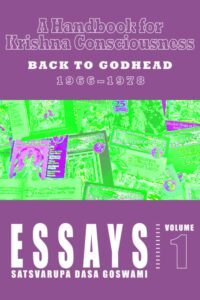
This collection of Satsvarūpa dāsa Goswami’s writings is comprised of essays that were originally published in Back to Godhead magazine between 1966 and 1978, and compiled in 1979 by Gita Nagari Press as the volume A Handbook for Kṛṣṇa Consciousness.
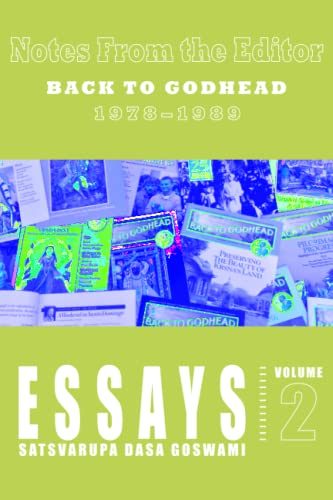
This second volume of Satsvarūpa dāsa Goswami’s Back to Godhead essays encompasses the last 11 years of his 20-year tenure as Editor-in-Chief of Back to Godhead magazine. The essays in this book consist mostly of SDG’s ‘Notes from the Editor’ column, which was typically featured towards the end of each issue starting in 1978 and running until Mahārāja retired from his duties as editor in 1989.
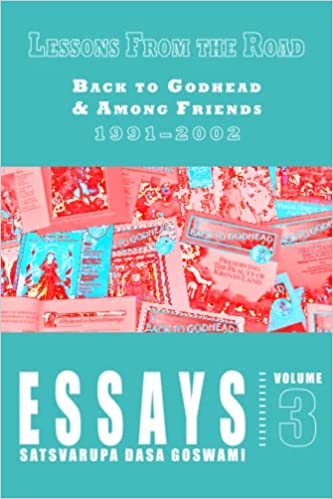
This collection of Satsvarupa dasa Goswami’s writings is comprised of essays that were originally published in Back to Godhead magazine between 1991 and 2002, picking up where Volume 2 leaves off. The volume is supplemented by essays about devotional service from issues of Satsvarupa dasa Goswami’s magazine, Among Friends, published in the 1990s.
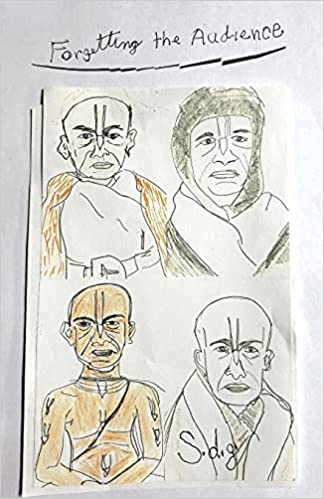
Writing Sessions at Castlegregory, Ireland, 1993Start slowly, start fastly, offer your obeisances to your spiritual master, His Divine Grace A.C. Bhaktivedanta Swami Prabhupada. You just drew his picture with your pencils. He appears carved out of wood…
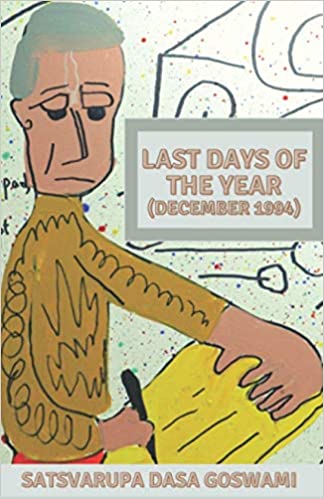 Last Days of the Year
Last Days of the YearI found I had hit a stride in my search for theme in writing, then began to feel the structure limiting me. After all, I had given myself precious time to write full-time; I wanted to enter the experience as fully as possible. For me, this means free-writing—writing sessions with no predetermined shape, theme, or topic…
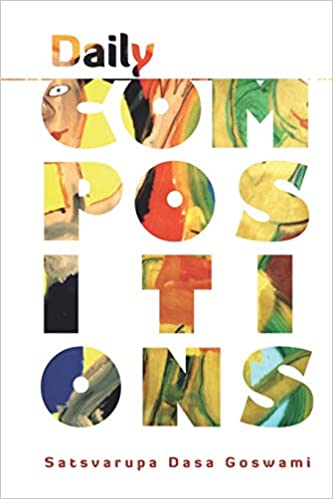 aily Compositions
aily CompositionsThis volume is comprised of three parts: prose meditations, free-writes, and poems each of which will be discussed in turn. As an introduction, a brief essay by the author, On Genre, has also been included to provide contextual coordinates for the writing which follows…
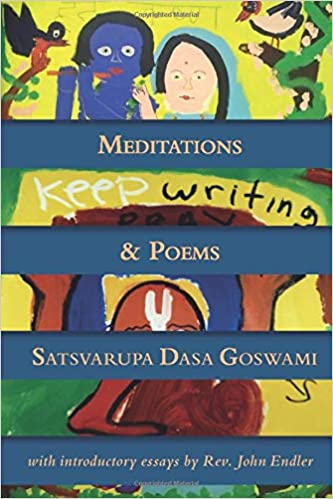 Meditations & Poems
Meditations & PoemsA comprehensive retrospective of poetic achievement and prose meditations, using a new trajectory described as “free-writing”. This volume will offer to readers an experience of the creativity versatility which is a hallmark of this author’s writing.
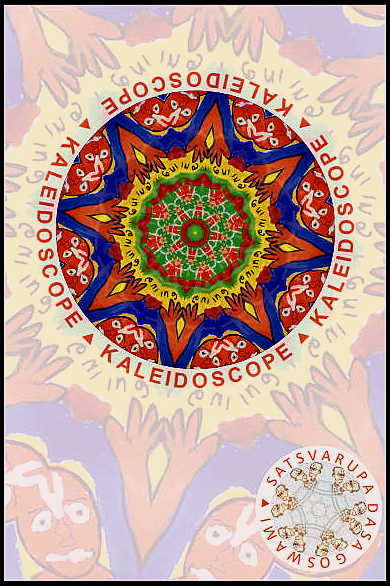 Kaleidoscope
KaleidoscopeStream of consciousness poetry that moves with the shifting shapes and colors characteristic of a kaleidoscope itself around the themes of authenticity. This is a book will transport you to the far reaches of the author’s heart and soul in daring ways and will move you to experience your own inner kaleidoscope.
Read more »
 A narrative poem. challenging and profound, about the journey of an itinerant monk who pursues new means of self-Seeking New Land
A narrative poem. challenging and profound, about the journey of an itinerant monk who pursues new means of self-Seeking New Landexpression.The reader is invited to discover his or her own spiritual pilgrimage within these pages as the author pushes every literary boundary to boldly create something wholly new and inspiring.